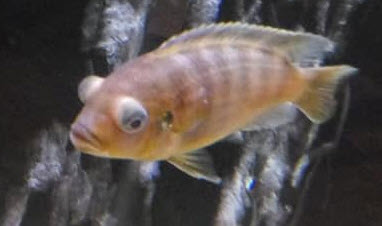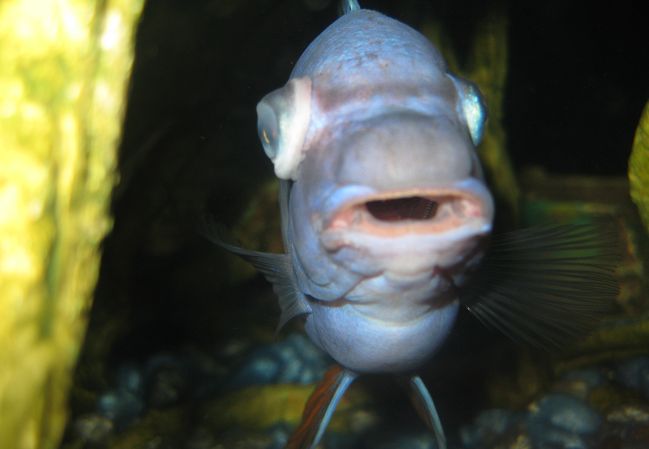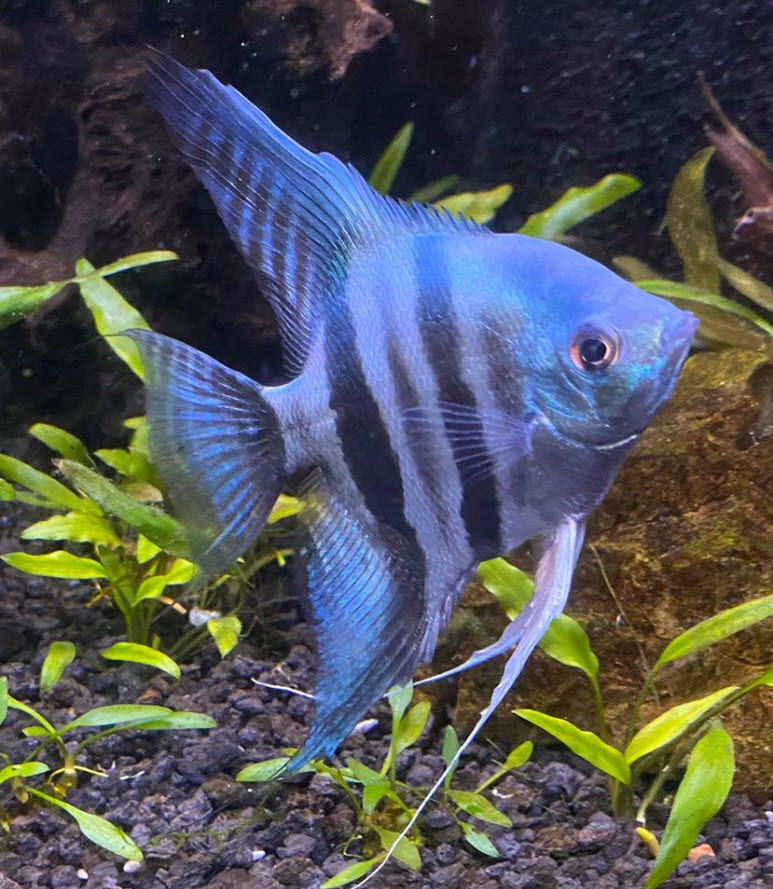
In “Popeye” the fish’s eyes bulge out. Popeye can be caused by many things, injury to the eye, environmental mycobacteriosis, even viruses. But the most common cause is a bacterium called Corynebacterium. This is a gram-positive bacterium best treated with erythromycin (API E.M. Erythromycin, Mardel Maracyn, Thomas Labs Fish Mycin) or penicillin.

Bacterial infections are most effectively treated with antibiotics in the food. Many believe (and the instructions on the antibiotics say!) that antibiotics need to be added to the water. They are simply incorrect. This controversial topic is covered in the following link:
12.5. Fish Don’t Drink
It is easy to make medicated food. Heat 1/4 cup water (two ounces or 58 milliliters, not a lot) in the microwave. Then blend seven grams of plain animal derived gelatin (Knox gelatin, one packet) into the hot solution with vigorous stirring. Take two tablespoons of dry commercial fish food (pellets or flake) and mix it with just a little of the hot water/ gelatin mixture. Add hot water/gelatin until you get a paste like consistency. If it gets too watery just add more food.
Then add just a “smidgen” (roughly 1/16 teaspoon, a 1% to 2% addition) of medication to the mud. If you are using more than one medication mix the medications together, then use just a “smidgen” of the mixture. If you are using a packet of medication, take just a “smidgen” of the packet contents. Mix and mash the whole mass thoroughly.
Spread it out into a pancake about 1/8th inch (3 mm) thick on a plastic film or a plate. Then put in the refrigerator. If you plan on keeping it for more than two weeks put it in a small plastic bag and freeze. Note that the exact amount of medication which goes into the food is not very important. Antibiotics can be overdosed pretty much with abandon as they are only toxic in large doses over a period of months.

Antibiotics are FDA approved and used for infections in humans and are very safe at just about any dosage for fish. Getting the exact dosage isn’t important since overdoses are only a problem if the fish are fed it for a significant period of time.
All the infected fish should be fed a steady diet of the antibiotic laced food for at least ten days. If it is one or two fish transfer the fish to a hospital aquarium and treat. If more than two fish have the problem one must treat the whole aquarium. Note antibiotics in the food do not affect the filters so they can be left in place and operating.
It is difficult to predict what will occur with popeye. Sometimes the popeye go down and sometimes they do not go down. A high percentage of the time it is fatal. The fatality rate goes up if both eyes are involved.
If you can’t resist the urge to treat the water, remove the biofiltration media (including sponge and/or foam) in the filters and put it in an open container for the duration of the treatment. Sometimes antibiotics kill the beneficial bacteria and sometimes they don’t. In any case the filter media will denature the antibiotics. Monitor the ammonia and would do a 50% water change if it spikes above 1 ppm. Reduce the amount of food fed by 2/3 rds.
Note that if antibiotics are not available, it is quite easy to take a pill or capsule of human antibiotic and use it for fish. If it is a pill just grind it up. Just be aware that the human antibiotics are about ten times more potent than the aquarium antibiotics, so just a “smidgen” in the food is more than enough. This is a very good option for the folks in Europe or Canada, where fish antibiotics are illegal.
The entire topic of bacterial infections in tropical aquarium fish is covered in more detail in this link:
10.3.11. Treating Bacteria
.
Return to Diseases Menu
Return to Bacterial Menu
.
Aquarium Science Website
The chapters shown below or on the right side in maroon lead to close to 400 articles on all aspects of keeping a freshwater aquarium. These articles have NO links to profit making sites and are thus unbiased in their recommendations, unlike all the for-profit sites you will find with Google. Bookmark and browse!
.

Dave says
In reply to R D “salt baths” have no effect on much of anything as far as fluid retention or popeye. Sounds like environmental mycobacteriosis (“Fish TB”) to me and as such is untreatable.
R D says
I’m treating a case of what might be Popeye using your antibiotic protocol (erythromycin in food). I’ve just reached the end of the 10 day regimen with no apparent change. It’s unclear if this means that the swelling is not coming from an infection (perhaps a tumor or deformity?) or if it will just take time for the swelling to subside. The fish (a blue gourami) has had it for several months and the swelling includes an area below the eye as well as the eye itself, only on one side. Behavior and coloring are normal, water parameters in the main and hospital tanks are good.
In addition to antibiotics, many sites talk about treating Popeye (also dropsy) with salt to “reduce swelling”. I had a commenter on a forum recommend “epsom salt baths” of 1tb of salt per gallon for 15 minutes to “reduce the fluid”. I’ve read your article on salt and it doesn’t seem to address anything like that. Do you have any feedback on whether to just wait it out, or try a salt treatment?